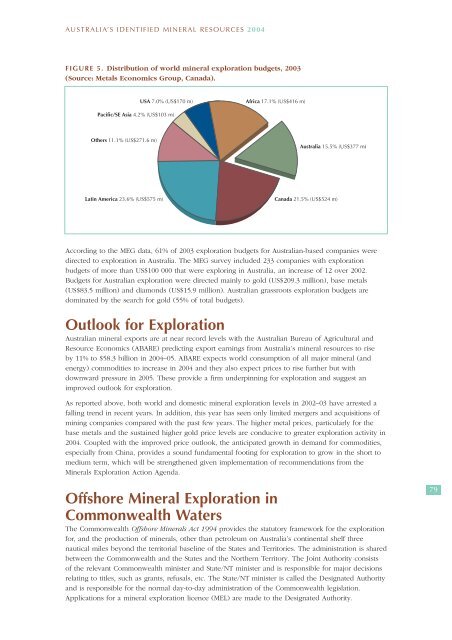australia's identified mineral resources 2004 - Geoscience Australia
australia's identified mineral resources 2004 - Geoscience Australia
australia's identified mineral resources 2004 - Geoscience Australia
You also want an ePaper? Increase the reach of your titles
YUMPU automatically turns print PDFs into web optimized ePapers that Google loves.
AUSTRALIA’S IDENTIFIED MINERAL RESOURCES <strong>2004</strong><br />
FIGURE 5. Distribution of world <strong>mineral</strong> exploration budgets, 2003<br />
(Source: Metals Economics Group, Canada).<br />
According to the MEG data, 61% of 2003 exploration budgets for <strong>Australia</strong>n-based companies were<br />
directed to exploration in <strong>Australia</strong>. The MEG survey included 233 companies with exploration<br />
budgets of more than US$100 000 that were exploring in <strong>Australia</strong>, an increase of 12 over 2002.<br />
Budgets for <strong>Australia</strong>n exploration were directed mainly to gold (US$209.3 million), base metals<br />
(US$83.5 million) and diamonds (US$15.9 million). <strong>Australia</strong>n grassroots exploration budgets are<br />
dominated by the search for gold (55% of total budgets).<br />
Outlook for Exploration<br />
<strong>Australia</strong>n <strong>mineral</strong> exports are at near record levels with the <strong>Australia</strong>n Bureau of Agricultural and<br />
Resource Economics (ABARE) predicting export earnings from <strong>Australia</strong>’s <strong>mineral</strong> <strong>resources</strong> to rise<br />
by 11% to $58.3 billion in <strong>2004</strong>–05. ABARE expects world consumption of all major <strong>mineral</strong> (and<br />
energy) commodities to increase in <strong>2004</strong> and they also expect prices to rise further but with<br />
downward pressure in 2005. These provide a firm underpinning for exploration and suggest an<br />
improved outlook for exploration.<br />
As reported above, both world and domestic <strong>mineral</strong> exploration levels in 2002–03 have arrested a<br />
falling trend in recent years. In addition, this year has seen only limited mergers and acquisitions of<br />
mining companies compared with the past few years. The higher metal prices, particularly for the<br />
base metals and the sustained higher gold price levels are conducive to greater exploration activity in<br />
<strong>2004</strong>. Coupled with the improved price outlook, the anticipated growth in demand for commodities,<br />
especially from China, provides a sound fundamental footing for exploration to grow in the short to<br />
medium term, which will be strengthened given implementation of recommendations from the<br />
Minerals Exploration Action Agenda.<br />
Offshore Mineral Exploration in<br />
Commonwealth Waters<br />
The Commonwealth Offshore Minerals Act 1994 provides the statutory framework for the exploration<br />
for, and the production of <strong>mineral</strong>s, other than petroleum on <strong>Australia</strong>’s continental shelf three<br />
nautical miles beyond the territorial baseline of the States and Territories. The administration is shared<br />
between the Commonwealth and the States and the Northern Territory. The Joint Authority consists<br />
of the relevant Commonwealth minister and State/NT minister and is responsible for major decisions<br />
relating to titles, such as grants, refusals, etc. The State/NT minister is called the Designated Authority<br />
and is responsible for the normal day-to-day administration of the Commonwealth legislation.<br />
Applications for a <strong>mineral</strong> exploration licence (MEL) are made to the Designated Authority.<br />
79

















